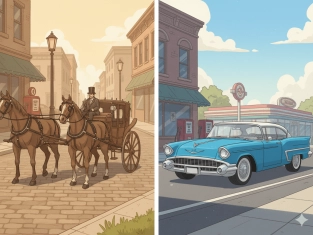Past Perfect Continuous
Table of Contents
Exercises
Explanation
1. Form
Affirmative
had been + verb-ing
-
I had been studying English for months before I took the exam.
-
She had been exercising for an hour before she noticed the time.
-
They had been discussing the project before the manager arrived.
Negative
had not (hadn’t) been + verb-ing
-
I hadn’t been sleeping much before the trip.
-
The children hadn’t been behaving well before their parents came home.
-
He hadn’t been training regularly before the race.
Questions
Had + subject + been + verb-ing?
-
Had you been waiting long before the doors opened?
-
Had he been living in that town before he got married?
-
Had they been working together before the new project started?
Wh- Questions
Wh-word + had + subject + been + verb-ing?
-
How long had she been writing before she took a break?
-
What had you been thinking before you changed your mind?
-
Where had they been staying before they found an apartment?
2. When Do We Use the Past Perfect Continuous?
A. To show a long action before another past event
This tense emphasizes how long something continued before a later action.
-
He had been studying medicine for five years before he entered his final exams.
-
We had been waiting outside for twenty minutes before the museum opened.
-
They had been fixing the computer for hours before it finally worked.
This use helps the listener understand the background of a past situation.
B. To explain the reason or cause of something in the past
The earlier action explains a later result.
-
She was exhausted because she had been running all afternoon.
-
His shoes were muddy because he had been walking through the fields.
-
They were annoyed because they had been standing in the cold for too long.
This use connects a past activity to a past result.
3. Time Expressions Used with the Past Perfect Continuous
We commonly use expressions that show duration and starting points:
Duration
-
for an hour / for two days / for several months
-
for a long time
-
for ages
Starting point
-
since morning / since Monday / since 2015
-
since he moved / since they met
Other useful expressions
-
all morning / all afternoon / all week
-
before
-
until / till (often in negative sentences)
Examples:
- She had been working at the company for five years before she got promoted.
- They hadn’t been feeling well until they got some rest.
- He had been living there since 2010 before he moved abroad.
- We had been playing all afternoon before it got dark.
Quick Summary
|
Meaning |
Form |
Example |
|
Long action before another past moment |
had been + verb-ing |
She had been cooking for two hours before we arrived. |
|
Negative |
hadn’t been + verb-ing |
He hadn’t been practicing much before the concert. |
|
Question |
Had + subject + been + verb-ing? |
Had they been waiting long? |
The Past Perfect Continuous is especially useful when you want to describe background activity, show duration, or explain why something in the past happened.

